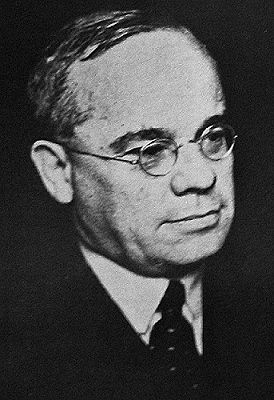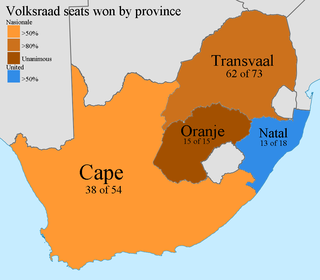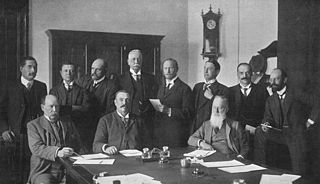Related Research Articles

The Transvaal Colony was the name used to refer to the Transvaal region during the period of direct British rule and military occupation between the end of the Second Boer War in 1902 when the South African Republic was dissolved, and the establishment of the Union of South Africa in 1910. The borders of the Transvaal Colony were larger than the defeated South African Republic. In 1910 the entire territory became the Transvaal Province of the Union of South Africa.
Elections in South Africa are held for the National Assembly, National Council of Provinces, provincial legislatures and municipal councils. Elections follow every 2 to 3 years with General Elections and Municipal Elections. The electoral system is based on party-list proportional representation, which means that parties are represented in proportion to their electoral support. For municipal councils there is a mixed-member system in which wards elect individual councillors alongside those named from party lists.

Jan Hendrik Hofmeyr was a South African politician and intellectual in the years preceding apartheid. In his lifetime he was regarded as one of the cleverest men in the country, and it was widely expected that he would eventually become Prime Minister of South Africa. He came from a well-known Afrikaner family; his uncle, also Jan Hendrik Hofmeyr but known affectionately as "Onze Jan" among fellow Afrikaners, was a famous figure in the Afrikaans language movement.
The Senate was the upper house of the Parliament of South Africa between 1910 and its abolition from 1 January 1981, and between 1994 and 1997.

General elections were held in South Africa on 15 September 1910 to elect the 121 members of the House of Assembly. They were the first general election after the Union of South Africa was created on 31 May 1910.

General elections were held in South Africa on 15 April 1953. The elections consolidated the position of the National Party under D. F. Malan, which won an absolute majority of the 156 elected seats in the House of Assembly, also receiving the most votes. Its first-time majority of the white electorate would be retained until the 1989 elections.

General elections were held in South Africa on 16 April 1958. The result was a victory for the National Party, now under the leadership of J. G. Strijdom after the retirement of D. F. Malan in 1954. The opposition United Party campaigned for the first time under De Villiers Graaff, who would remain party leader for two decades.

General elections were held in South Africa on 30 March 1966. The result was another comprehensive victory for the National Party under H. F. Verwoerd.

General elections were held in South Africa on 17 May 1933 to elect the 150 members of the House of Assembly. The National Party won half the seats in the House, but the coalition with the South African Party continued.

General elections were held in South Africa on 18 May 1938 to elect the 150 members of the House of Assembly. The United Party won an absolute majority.

General elections were held in South Africa on 7 July 1943 to elect the 150 members of the House of Assembly. The United Party of Jan Smuts won an absolute majority.

The South African Labour Party, was a South African political party formed in March 1910 in the newly created Union of South Africa following discussions between trade unions, the Transvaal Independent Labour Party, and the Natal Labour Party. It was a professedly democratic socialist party representing the interests of the white working class.

The South Africa Act 1909 was an act of the Parliament of the United Kingdom that created the Union of South Africa out of the former Cape, Natal, Orange River, and Transvaal colonies. The Act also allowed for potential admission of Rhodesia into the Union, a proposal rejected by Rhodesian colonists in a 1922 referendum. The draft proposal was supported by the four colonial parliaments, but was opposed by Cape Colony premier W. P. Schreiner, who raised concerns that it would strip rights from non-white South Africans.

The House of Assembly was the lower house of the Parliament of South Africa from 1910 to 1981, the sole parliamentary chamber between 1981 and 1984, and latterly the white representative house of the Tricameral Parliament from 1984 to 1994, when it was replaced by the current National Assembly. Throughout its history, it was exclusively constituted of white members who were elected to office predominantly by white citizens, though until 1960 and 1970, respectively, some Black Africans and Coloureds in the Cape Province voted under a restricted form of suffrage.
The Cape Provincial Council was the provincial council of the Cape Province of South Africa. It was created by the South Africa Act 1909, with effect from the formation of the Union of South Africa on 31 May 1910. The first election to the provincial council took place on 15 September 1910.
The Natal Provincial Council was the provincial council of Natal Province in South Africa. It was created by the South Africa Act 1909, with effect from the formation of the Union of South Africa on 31 May 1910.
The Orange Free State Provincial Council was the provincial council of the Orange Free State Province in South Africa. It was created by the South Africa Act 1909, with effect from the formation of the Union of South Africa on 31 May 1910.

The Constitution of 1961 was the fundamental law of South Africa for two decades. Under the terms of the constitution South Africa left the Commonwealth and became a republic.
The provincial councils were the legislatures of the four original provinces of South Africa. They were created at the foundation of the Union of South Africa in 1910, and abolished in 1986 when they were replaced by a strengthened executive appointed by the State President. The four provincial councils were the Cape Provincial Council, the Natal Provincial Council, the Transvaal Provincial Council and the Orange Free State Provincial Council.

The National Convention, also known as the Convention on the Closer Union of South Africa or the Closer Union Convention, was a constitutional convention held between 1908 and 1909 in Durban, Cape Town and Bloemfontein. The convention led to the adoption of the South Africa Act by the British Parliament and thus to the creation of the Union of South Africa. The four colonies of the area that would become South Africa - the Cape Colony, Natal Colony, the Orange River Colony and the Transvaal Colony - were represented at the convention, along with a delegation from Rhodesia. There were 33 delegates in total, with the Cape being represented by 12, the Transvaal eight, the Orange River five, Natal five, and Rhodesia three. The convention was held behind closed doors, in the fear that a public affair would lead delegates to refuse compromising on contentious areas of disagreement. All the delegates were white men, a third of them were farmers, ten were lawyers, and some were academics. Two-thirds had fought on either side of the Second Boer War.
References
- Keesing's Contemporary Archives (various volumes)
- South Africa 1982: Official Yearbook of the Republic of South Africa, published by Chris van Rensburg Publications
- The South African Constitution, by H.J. May (3rd edition 1955, Juta & Co)
- ↑ The Times, edition of 26 July 1910, confirms the setting of the election date
- ↑ Keesing's Contemporary Archives 1985, page 33831. It was announced on 6 May 1985 that the Provincial Councils were to be phased out between 29 April and 30 June 1986.
- ↑ Keesing's Contemporary Archives 1940–1943, page 4859 (postponement of the 1941 elections)
- ↑ South Africa 1982, page 153 (provisions in the 1909 and 1973 Acts, about the terms of Provincial Councils)
- ↑ The South African Constitution, pp 602–604
- ↑ The South African Constitution, pp 365–367
- ↑ Keesing's Contemporary Archives 1934–1937, page 2247
- ↑ Keesing's Contemporary Archives 1943–1946, page 6154
- ↑ Keesing's Contemporary Archives 1948–1950, page 9964
- ↑ Keesing's Contemporary Archives 1952–1954, page 13794
- ↑ Keesing's Contemporary Archives 1965–1966, page 20702 (1959 results mentioned with the 1965 results)
- ↑ Keesing's Contemporary Archives 1965–1966, page 20702
- ↑ Keesing's Contemporary Archives 1969–1970, page 24341
- ↑ Keesing's Contemporary Archives 1974, page 26541
- ↑ Keesing's Contemporary Archives 1978, page 28813
- ↑ Keesing's Contemporary Archives 1981, page 30973